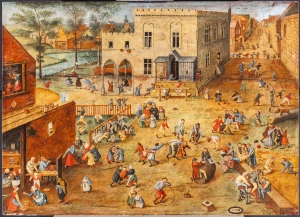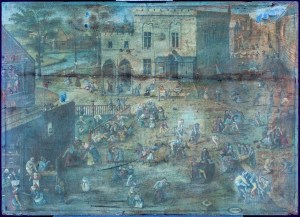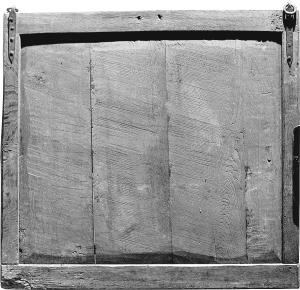BruegelNow
brueghel
The Bruegel Success Story: Papers Presented at Symposium XXI for the Study of Underdrawing and Technology in Painting, Brussels, 12 – 14 September 2018 (Edited by Christina Currie, in collaboration with Dominique Allart, Bart Fransen, Cyriel Stroo and Dominique Vanwijnsberghe (Peeters, 2021))- Monograph Review
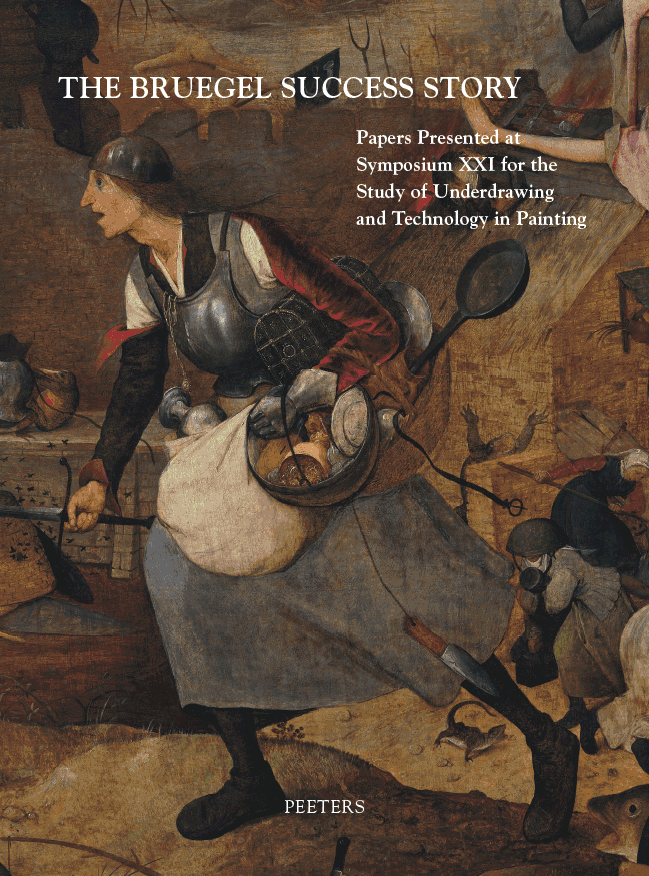
The 450 anniversary of Pieter Bruegel the Elder’s death, in 2019, ushered in many exciting projects to commemorate the milestone. Perhaps none as rich and diverse as this conference and accompanying 550-page monograph, which included groundbreaking papers on all aspects of the Bruegel family.
I was fortunate to attend the conference and can happily replace my scribbled notes and crude drawings created when seated in the audience with this exquisite monograph. It is perhaps the most beautifully illustrated Bruegel monograph based on conference papers that I’ve ever seen. Many of the Bruegel paintings reproduced in the monograph were recently cleaned and restored, which the monograph fully captures with large, rich illustrations. Not only are the paintings themselves reproduced, but enlarged details of critical sections of the paintings are featured.
The monograph’s first section includes a series of articles on the newly restored Dulle Griet, done in preparation for the Bruegel exhibition at the Kunsthistorisches Museum in Vienna in 2018 -19, in conjunction with the Museum Mayer Vanden Bergh in Antwerp, where the painting hangs. The conference brought to light that Dulle Griet was likely transferred from cartoon tracings after Bruegel carefully worked out the picture on other media. The recent cleaning of the panel has uncovered that many of the painting’s pigments have faded or darkened. The cleaning exposed a vital missing feature of the painting, the date of execution of the work. A fascinating essay details a colored drawing of Dulle Griet, housed at the Kunstpalast, Dusseldorf. The drawing helps convey the painting’s original colors which have faded over the years. The analysis of the paper on which the drawing was rendered revealed a watermark from no earlier than 1578, confirming its status as a copy.
The second section of the monograph is devoted to a group of papers related to Pieter Bruegel the Elder and his practices. Groundbreaking scholarship considers Bruegel’s paintings on distemper on lined canvas (Tuchlein), a format which Bruegel was one of the last to utilize. Essays on The Adoration of the Magi (in the Royal Museum of Fine Arts, Belgium), by Veronique Bucken, provide intriguing details about this format of painting.
Bruegel used a variety of methods to paint his monumental panel paintings. For example, compared to Dulle Griet, the Detroit Wedding Dance, was drawn free hand using an “extensive and vigorous drawing with numerous adjustments to the modeling and shading of the figures, but not the composition as a whole.” Another surprise is the finding that the Wedding Dance was altered from its initial composition size through the addition of a top border. This is discussed in an intriguing paper by Marie Postec and Pascale Fraiture that compares the Detroit version with a little studied copy after Bruegel the Elder in Antwerp.
The third section of the monograph is devoted to Jan Brueghel, son of Pieter the Elder. Several essays review the difference between Jan and his elder brother, Pieter the Younger, in terms of creating copies after their father’s works. Elizabeth Alice Honig’s “Copia, Copying and Painterly Eloquence,” describes Jan Brueghel the Elder and the notion of copia, as articulated for a Renaissance audience by Erasmus in his De Copia. In Uta Neidhardt’s paper, “The Master of the Dresden Landscape with the Continence of Scipio: A Journeyman in the studio of Jan Brueghel the Elder?” identifies two different “hands” working in Jan Brueghel’s studio. The essay is important because so little is known about those painters that worked in proximity to Jan’s studio. The essay remarks on the difficulty in assigning works to specific studio hands. (An issue that was on display just last month, when Christie’s sold a work dated 1608 stamped in copper by “Pieter Brueghel III,” owning to what is undoubtedly a spurious signature.) Larry Silver’s essay “Sibling Rivalry: Jan Brueghel’s Rediscovered Early Crucifixion,” focuses on the difference between Jan the Elder and Pieter the Younger’s treatment of a lost composition of Pieter the Elder. As can be seen frequently in the brother’s work, Jan the Elder creatively re-invents works based on his father’s design, while Pieter the Younger copies his father’s works in a fairly precise manner.
Section four investigates Bruegel’s network and legacies. The question of who painted some of the works after Bruegel the Elder’s untimely death in 1569 and his sons first paintings decades later remains a key mystery yet to be solved. Intriguing essays related to Bruegel’s networks, contracts and connection to homes and studios in Antwerp help put pieces of the puzzle together. Lost works like The Heath allow us to ponder questions of authorship and the number and varieties of copies made (most likely) by non-Brueghels.
The Bruegel “craze” of the early years of the 1600’s and the aftermath of Bruegel’s death is also covered in this section, which details the many ramifications of the aftermath of Bruegel The Elder’s untimely death. The monograph is rife with intriguing aspects of Bruegel’s legacy, including “Peasant Passions: Pieter Bruegel and his Aftermath” (Ethan Matt Kavaler) and “In Search of the Bruegel’s Family Homes and Studios in Antwerp” (Petra Maclot).
The devotion of eight pages to the restored Dulle Griet in an addendum of the monograph speaks to the exquisite care taken to showcase the paintings of Bruegel and his family.
That the quality of the monograph, with all of its finely detailed images, matches the uniformly high quality of the papers within, is a testament to the care that went into creating this handsome volume. It is wonderful that the conference papers are presented in such rich surroundings.
The full table of contents of this stunning monograph is below:



Event Preview – “The Bruegel Success Story,” 12-14 September 2018

We were fortunate enough to obtain an exclusive preview of the upcoming event, “The Bruegel Success Story,” to be held 12-14 September 2018 in Brussels, Belgium. (http://conf.kikirpa.be/bruegel2018/) This can’t-miss conference kicks off a number of activities celebrating the life and work of Pieter Bruegel the Elder, who died 450 years ago. We corresponded with one of the conference organizers, Dr. Christina Currie, Royal Institute for Cultural Heritage (KIK-IRPA), who gave us this exciting preview of the conference:
1) What led to focusing on Bruegel and his family for this conference?
The year 2019 is the 450th anniversary of Pieter Bruegel the Elder’s death. In Belgium and in Vienna, this is being marked by a series of events that will celebrate his career and his influence on later generations. The Bruegel Success Story conference, organised by the Royal Institute for Cultural Heritage (KIK-IRPA) in collaboration with the Royal Museums of Fine Arts in Belgium, will kick off this season of activities and will give a riveting context for all the subsequent Bruegel themed happenings.
2) What will attendees of the conference learn?
Attendees will be exposed to the very latest in Bruegel research through the eyes of experts from all around the world. Eminent keynote speakers Leen Huet (Belgium), Elizabeth Honig (USA) and Matt Kavaler (Canada) will introduce each of the three days. Over the course of the conference, presentations will cover the life and work of Pieter Bruegel the Elder as well as that of his artistic progeny, including the astonishingly exact replicas of his paintings produced by his elder son Pieter Brueghel the Younger and the exquisite paintings of his younger son Jan Brueghel the Elder. Fascinating new findings on the creative process of Bruegel the Elder as well as that of his dynasty will be presented for the first time, thanks to new high resolution scientific imagery. But the conference does not neglect the essential meaning behind these beautiful works of art. Several speakers will concentrate specifically on the interpretation of Bruegel’s paintings and drawings, which can be quite subversive when seen in an historical context. Interesting new facts about the life, family and homes of the Bruegel family will also be revealed.
3) Who should attend this conference?
The Bruegel Success Story is intended for all art lovers with an interest in Flemish painting and particularly those attracted to Bruegelian themes such as peasant dances, landscapes, proverbs and maniacal scenes. Students of art history, art historians, restorers and collectors should not pass up this opportunity.
3) There are a number of papers focusing on Pieter Bruegel the Elder’s painting “Dulle Griet.” Why is that painting receiving attention now?
The Dulle Griet, in the collection of the Mayer van den Bergh Museum in Antwerp, has just undergone the most thorough conservation treatment in its recent history. This has brought to light many original features that were previously hidden behind a murky brown varnish and overpaint. The restoration, carried out at the Royal Institute for Cultural Institute in Brussels, was accompanied by in-depth technical examination that resulted in fascinating discoveries about Bruegel the Elder’s creative process. The conference attendees will hear how this great artist conceived, developed and painted this bizarre macabre composition. Leen Huet, one of the keynote speakers and author of a sensational recent biography on Bruegel the Elder, will delve into the hidden meaning behind the Dulle Griet.
4) One of the biggest bombshells in recent years was the revelation in your book (“The Brueg(h)el Phenomenon”) that Bruegel the Elder’s two versions of “Landscape with the Fall of Icarus” were not painted by Bruegel the Elder. Will there be similar surprises unveiled at the conference?
I can say that attributions will be debated during the conference. This is always the case when a group of experts on a particular artist or dynasty get together. And it can lead to sparks flying as opinions naturally diverge!
5) There has also been a good deal of investigation into Bruegel’s extended family lately. What will attendees learn about Bruegel’s family at the conference?
Pieter Bruegel the Elder’s paintings were so loved that his son and heir Pieter Brueghel the Younger made his entire career out of producing replicas for an insatiable art market in the late sixteenth and early seventeenth century. Jan Brueghel, his younger brother, updated the family tradition, branching out into flower paintings, allegories and mythological themes. The next generation produced several renowned painters too, including Abraham Brueghel, who traded on the family name. The paintings of the Bruegel dynasty, as well as those of lesser-known artists working in the Bruegel tradition in the Low Countries and abroad, will feature amongst the exciting new material presented during the conference.
The Bruegel Success Story symposium – September 12 – 14, 2018, Brussels
A blockbuster conference containing the latest research on the Bruegel / Brueghel family of painters is being held this fall in Brussels. Many of the leading Bruegel scholars are presenting new findings related to the Bruegel dynasty.
Discoveries related to the Bruegel clan – including patriarch Pieter the Elder, sons Pieter Brueghel the Younger and Jan Brueghel the Elder and other members of the family – will be presented at the symposium. One of the highlights will be presentations related to Pieter Bruegel’s “Dulle Griet,” a painting in Antwerp which has recently undergone extensive investigation, research and cleaning.

The Bruegel / Brueghel clan continues to be top draws at museums and set records at auction (including toping high estimates at this week’s Old Master’s auctions in London).
Registration is open now for this impressive symposium.
More information and registration at http://conf.kikirpa.be/bruegel2018/.
————————————————————————–
Conference Venue: Royal Museum of Fine Arts of Belgium, Place du Musée, B-1000 Brussels.
THE PROGRAM
12 September 2018, WEDNESDAY
9:00 – 9:45 Registration at the Royal Museums of Fine Arts of Belgium
9:45 – 10:00 Welcome by Hilde De Clercq, director of the KIK-IRPA and Michel Draguet, director of the Royal Museums of Fine Arts of Belgium
CHAIR Lieve Watteeuw
10:00 – 10:40 KEYNOTE LECTURE: Leen Huet, The Surprises of Dulle Griet
10:40 – 11:00 Larry Silver, Sibling Rivalry: Jan Brueghel’s Rediscovered Early Crucifixion
11:00 – 11:20 Véronique Bücken, The Adoration of the Kings in the Royal Museums of Fine Arts of Belgium: Overview and new perspectives
11:20 – 11:30 Discussion
COFFEE BREAK 11:30 – 12:00
CHAIR Dominique Allart
12:00 – 12:20 Yao-Fen You, Ellen Hanspach-Bernal, Christina Bisulca and Aaron Steele, The Afterlife of the Detroit Wedding Dance: Visual Reception, Alterations and Reinterpretation
12:20 – 12:40 Manfred Sellink, Marie Postec and Pascale Fraiture, Dancing with the bride – a little studied copy after Bruegel the Elder
12.40 – 13.00 Mirjam Neumeister and Eva Ortner, Examination of the Brueghel holdings in the Alte Pinakothek/Bayerische Staatsgemäldesammlungen, Munich
13:00 – 13:10 Discussion
LUNCH BREAK 13:10 – 14:30
CHAIR Elizabeth Honig
14:30 – 14:50 Amy Orrock, Jan Brueghel the Elder’s Oil Sketches of Animals and Birds: Form, Function and Additions to the Oeuvre
14:50 – 15:10 René Lommez Gomes, Regarding the Character of Each Animal. An essay on form and colour in non-European fauna painted by Jan Brueghel the Elder
15:10 – 15:30 Uta Neidhardt, The Master of the Dresden “Landscape with the Continence of Scipio” – a journeyman in the studio of Jan Brueghel the Elder?
15:30 – 15:40 Discussion
COFFEE BREAK 15:40 – 16:10
CHAIR Bart Fransen
16.10 – 17.10 Christina Currie, Steven Saverwyns, Livia Depuydt, Pascale Fraiture, Jean-Albert Glatigny and Alexia Coudray, Lifting the veil: The Dulle Griet rediscovered through conservation, scientific imagery and analysis
Christina Currie, Steven Saverwyns, Sonja Brink, Dominique Allart, The coloured drawing of the Dulle Griet in the Kunstpalast, Dusseldorf: new findings on its status and dating
Dominique Allart and Christina Currie, Bruegel’s painting technique reappraised through the Dulle Griet
17:10 – 17:20 Discussion
18.00 Opening reception in Brussels Town Hall (Gothic and Marriage rooms)
13 September 2018, THURSDAY
9:00 Doors open
CHAIR Ethan Matt Kavaler
9:30 – 10:10 KEYNOTE LECTURE: Elizabeth Honig, Copia: Jan Brueghel and the Rhetoric and Practice of Abundance
10:10 – 10:30 Yoko Mori, Is Bruegel’s Sleeping Peasant an Image of Caricature?
10:30 – 10:50 Jamie Edwards, Erasmus’s De Copia and Bruegel the Elder’s ‘inverted’ Carrying of the Cross (1564): An ‘abundant style’ in Rhetoric, Literature and Art?
10:50 – 11:00 Discussion
COFFEE BREAK 11:00 – 11:30
CHAIR Leen Huet
11:30 – 11:50 Tine Meganck, Behind Bruegel: how “close viewing” may reveal original ownership
11:50 – 12:10 Annick Born, Behind the scenes in Pieter Bruegel’s success story: the network of the in-laws and their relatives
12:10 – 12:30 Petra Maclot, In Search of the Bruegel’s Homes and Workshops in Antwerp
12:30 – 12:40 Discussion
LUNCH BREAK 12:40 – 14:40
CHAIR Christina Currie
14:40 – 15:00 Lieve Watteeuw, Marina Van Bos, Joris Van Grieken and Maarten Bassens, ‘View on the Street of Messina’, circle of Pieter Bruegel the Elder: Drawing techniques and materials examined
15:00 – 15:20 Maarten Bassens, “Diet wel aenmerct, die siet groot wondere”. Retracing Pieter Bruegel’s printing press(es) by means of a typographical inquiry
15:20 – 15:40 Edward Wouk, Pieter Bruegel’s Subversive Drawings
15:40 – 15:50 Discussion
COFFEE BREAK 15:50 – 16:20
CHAIR Valentine Henderiks
16:20 – 16:40 Jürgen Muller, Pieter Bruegel’s “The Triumph of Death” revisited
16:40 – 17:00 Jan Muylle, A lost painting of Pieter Bruegel, The Hoy
17:00 – 17:20 Hilde Cuvelier, Max J. Friedländer’s perception of Bruegel: Rereading the connoisseur with historical perspective
17:20 – 17:30 Discussion
14 September 2018, FRIDAY
9.00 Doors open
CHAIR Manfred Sellink
9:30 – 10:10 KEYNOTE LECTURE: Ethan Matt Kavaler, Peasant Bruegel and his Aftermath
10:10 – 10:30 Christina Currie and Dominique Allart, The creative process in the Triumph of Death by Pieter Bruegel the Elder and creative solutions in two versions by his sons
10:30 – 10:50 Anne Haack Christensen, David Buti, Arie Pappot, Eva de la Fuente Pedersen and Jørgen Wadum, The father, the son, the followers: Six Brueg(h)els in Copenhagen examined
10:50 – 11:00 Discussion
COFFEE BREAK 11:00 – 11:30
CHAIR Dominique Vanwijnsberghe
11:30 – 11:50 Lorne Campbell, Bruegel and Beuckelaer: contacts and contrasts
11:50 – 12:10 Patrick Le Chanu, Pieter Bruegel the Elder and France
12:10 – 12:30 Daan van Heesch, Hercules et simia: the Peculiar Afterlife of Bruegel in Sixteenth-Century Segovia
12:30 – 12:50 Francesco Ruvolo, The Painter and the Prince. Abraham Brueghel and Don Antonio Ruffo. Artistic and cultural relations in Messina from the seventeenth century. With unpublished documents
12:50 – 13:00 Discussion
LUNCH BREAK 13:00 – 14:30
CHAIR Véronique Bücken
14.30 – 14.50 Lucinda Timmermans, Painted ‘teljoren’ by the Bruegel family
14:50 – 15:10 Pascale Fraiture and Ian Tyers, Dendrochronology and the Bruegel dynasty
15:10 – 15:30 Jørgen Wadum and Ingrid Moortgat, An enigmatic panel maker from Antwerp and his supply to the Brueghels
15:30 – 15:50 Ron Spronk, Elke Oberthaler, Sabine Pénot, and Manfred Sellink, with Alice Hoppe Harnoncourt, The Two Towers: Pieter Bruegel’s Tower of Babel panels in Vienna and Rotterdam
15:50 – 16.00 Discussion
16:00 – 16:10 Closing Remarks: Christina Currie and Dominque Allart
A Brueghel In 3 Parts

Approximately 150 years ago, a Welsh owner of a large format Pieter Brueghel the Younger paining, “Peasant Wedding Dance in a Barn,” was apparently offended by several images in the painting and chopped the painting into several smaller paintings, removing the offending images from the cut section(s).
The 3 remaining sections of the painting, when superimposed on the large painting, can be seen above. What was cut from the painting are images of a dancing man’s codpiece, a man reaching under a woman’s skirt and other images that must have offended the Welsh owner’s sensibilities.
It is a shame that the Welsh owner took the drastic action of hacking the painting into sections to remove the offending images. Other versions of the work included judicious overpainting, which would have removed the offending images without necessitating cutting the panel into pieces.
One of the three fragments of the painting recently came to light through a New York auction. This fragment has wonderful colors and careful modeling of facial features. Judging by the attention to detail (such as the delicate rendering of the thread on the dancer’s shirt), this work seems to have been one of the best of the known 27 versions painted by Brueghel the Younger and his workshop. This painting is likely an autograph work by the hand of Brueghel the Younger (see image below).
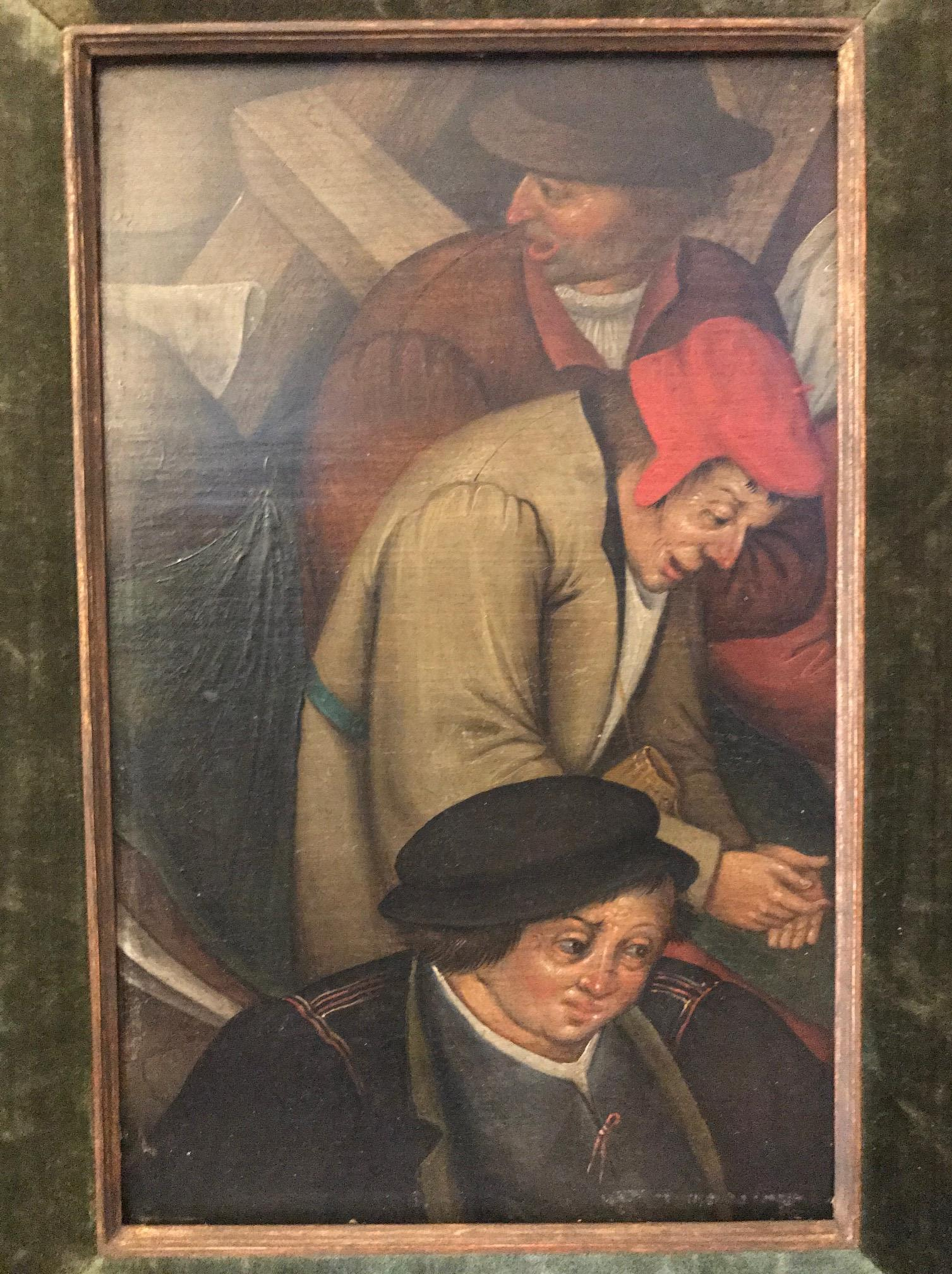
The back of the panel has both the Antwerp panel maker’s mark in the shape of the Antwerp castle with two hands above and the clover mark of Michael Claessen, the dean of the Antwerp panel makers and a frequent panel maker to Pieter Brueghel the Younger. Both marks point to a specific date range for the painting. The Antwerp panel maker’s mark was used 1619-1638, and Claessen created panels between 1615-1637. Therefore, Brueghel the Younger must have executed this work after 1616 and before 1637.
Since Pieter Brueghel the Younger typically copied works of his father, it is natural to look for the original work painted by his father. Unfortunately, the original work no longer exists or has not yet been identified.
This blog is on a search for the other 2 fragments of this painting. If anyone knows the whereabouts of them, please contact the editor.
Sources for this posting:
Jorgen Wadum, “The Antwerp Brand on Paintings on Panel” in Looking Through Paintings, Emma Hermens, Archetype Books, 2007 (and private correspondence)
Klaus Ertz, Pieter Brueghel der Jüngere 1564–1637/1638. Die Gemälde mit kritischem Oeuvrekatalog, Lingen 1998–2000, (and private correspondence)
Thomas Bodkin, ‘The peasant wedding’, Burlington Magazine 1930 (56), p. 98-105
Exhibit Review – Bruegel: Defining A Dynasty
Several weeks ago I wrote about the catalog for the exhibit Bruegel Defining a Dynasty by Amy Orrock. Now, having seen the exhibit firsthand, I can confirm what I suspected after reading the catalog; that the exhibit, presented by outgoing museum director Jennifer Scott, is a marvelous exploration of the Bruegel family brought vividly to life.
Smartly, the exhibit begins with an overview of the Bruegel family tree, showing the relations of family members whose paintings will be viewed in the coming rooms.
A work from the genius at the top of the family tree, Pieter Bruegel the Elder, greets us as we enter the first room. The Adoration of the Kings, 1564, is Bruegel at his finest, a visual feast for the eyes along with not-subtle commentary that reflects how some on-lookers appeared to be more interested in the gifts brought for Christ than the child himself.
One of the exhibition’s aims was to show that Pieter the Elder’s two male children, Pieter the Younger and Jan the Elder, were not simply copyists, but added their own personalities to scenes that their father first painted. Comparing Jan the Elder’s version of The Adoration of the Kings, for example, is a wonderful example of how Jan adjusted and enhanced his father’s composition, by adding elements like a town in the background and details of the dilapidated stable where the scene is set.
The Bruegel exhibit also showcases works painted outside of the family, such as the version of Netherlandish Proverbs included here. This work is intriguing because it omits one fourth of the proverbs found in Bruegel the Elder’s painting. Further, it is much smaller than the copies made by Pieter the Younger and his studio, and does not contain the characteristic underdrawing found in Pieter the Younger’s works. Scientific analysis indicates that it was produced at approximately the same time as the works by Pieter the Younger’s studio in the early seventeenth century. However, this work contains aspects of the completed Bruegel the Elder painting that are not included in Pieter the Younger’s copies. This means that while Bruegel the Younger did not have access to his father’s completed painting, the painter of this work did have access. How non-family members could have accessed the painting is just one of the mysteries discussed in the exhibit.
Family members showed their expertise with other genres such as still lifes, which Jan the Elder and Jan the Younger were undisputed masters. Jan Brueghel the Elder’s grandson, Jan van Kessel, is represented in four small paintings that depict insects set against a light background. The pictures gleam through the copper substructure, with the insects painted in minute detail.
There are many mysteries still to be solved within the family, such as what was Pieter Bruegel III’s role in his father Pieter Brueghel the Younger’s workshop. Exhibits like this one allow us to revel in the depth and breadth of the family’s output, and consider the many mysteries still be examined.
(Bruegel: Defining a Dynasty at the Holburne Museum, Bath, England, February 11 – June 4, 2017 £10 Full Price | £9 concessions | £5 Art Fund, Full Time Student | FREE Entry to under 16s and All Museum Members)
Bruegel: Defining a Dynasty
Bruegel: Defining a Dynasty by Amy Orrock (Philip Wilson Publishers, 2017). Published to accompany the exhibition Bruegel: Defining a Dynasty (11 February – 4 June, 2017) at the Holburne Museum, Bath, UK.
Perhaps the best known dynasty in the history of painters, the Bruegel family flourished for nearly 150 years. This book, written in conjunction with an exhibit that showcases the depth and breadth of the Bruegel clan, provides a history of the family along with visually dazzling key works.
The centerpiece of the book is the section that details the attribution of The Wedding Dance in the Open Air to Pieter Brueghel the Younger. The “heavy dancers” depicted in the painting are some of the best known figures of Bruegel’s oeuvre. Yet this painting was originally thought to be a copy by a follower of Brueghel the Younger.
Key to the attribution was the cleaning of the painting. The pre- and post-conservation images portray a drastically different work. Before conservation the work looked like a nocturnal scene, covered in layers of discolored varnish and numerous retouching. The restoration, carried out by Elizabeth Holford, led to a greatly lightened, visually stunning painting.
Christina Currie and Dominique Allart, who wrote the definitive scientific examination of Pieter Brueghel the Younger’s output several years ago, examined the work and secured its attributed to the artist. They studied the painting’s underdrawing, which conformed to paintings typical of Pieter Brueghel the Younger. They concluded that he work “… equals that found in the other versions studied, signifying that it belongs within” the Brueghel the Younger group.
This monograph successfully demonstrates that the Bruegel family wasn’t only a painter of dancing peasants. For example, Pieter’s younger brother, Jan Brueghel the Elder, created beautiful still life paintings. Unlike his brother, Jan collaborated extensively with other painters. Over 40 percent of his painted output consists of collaborate works. The friend of Rubens and Van Dyke, Jan the Elder’s works sold for 10 or 20 times the price of his older brother’s works. (A situation that has reversed itself in the late 20th and 21st century, where Pieter’s works sell for many millions while Jan’s works are available at a much lower sum.)
Jan Brueghel the Elder’s grandson, Jan van Kessel, excelled in small paintings of “naturalia,” which mimicked insect and other types of animal specimen that were difficult or impossible to obtain. Highlighted in the book are four small paintings on copper panels that depict native insects against light backgrounds.
This highly recommended book not only provides a wonderful overview of the Bruegel family, but also made me want to immediately rush to the Holburne museum to see the paintings in person. (I will have to wait a few weeks until I am able to do this.)
Sharp eye nets €100K+ for Pieter Brueghel II Painting
An interesting Pieter Brueghel II painting came to our attention in late May of this year. Listed as “PIETER BRUEGHEL (attr. a)” in the June 1, 2016 auction catalog for the Genoa, Italy auction house Wannenes, this small 18 cm tondo work leapt from the catalog pages with its delicate brushwork and exacting execution. The work had an estimate of only €1,600 – €1,800, yet shimmered from the catalog pages.
Details such as the delicate red thread winding around the pants of one of the peasants was a clear sign that this work should not simply be attributed to Pieter Brueghel II, but was likely an original work by the artist. A quick review of Klaus Ertz’ catalog raisonne of Pieter Brueghel II showed that other similar works were painted by the artist and his workshop, but this clearly escaped the notice of the seller as well as Wannenes.
The day of the auction arrived, and when the lot (number 504) was put up for bid, prices quickly skyrocketed beyond the paltry estimate. Within a minute bidding was already over €30,000. The auction ended with the work selling for approximately €68,000 (€74,400 with buyer’s premium). We wondered how soon we would see the work at auction again, this time with a much larger price attached.
It didn’t take long for the work to reappear. Scarcely more than three months after the June 1 auction, the work has appeared again, to be sold by Dorotheum in Vienna on October 18, 2016. In a new frame and with a certificate of authenticity from world renowned Brueghel II expert Dr. Klaus Ertz, the work now carries an estimate for €180,000 – €220,000.
In the intervening moths the painting appears to have undergone cleaning, with some of the paint loss evident in the Wannenes version corrected and the overall work removed of centuries of grime (see comparison of images below).
Congratulations to the initial buyer who will likely be able to turn a tidy profit of €100,000 or more, depending on the final sale price. This is another classic example of how cleaning a painting, fitting it in a handsome new frame and, most importantly, authentication from Dr. Klaus Ertz can transform the value of a Bruegel II.

Version sold At Wannenes – June 2016

Version to be sold October 18, 2016 at Palais Dorotheum
Searching for Niclaes Jongelinck’s House
One of Pieter Bruegel the Elder’s greatest patrons was Niclaes Jongelinck, who owned 16 of his paintings. The paintings were hung at Niclaes Jongelinck’s villa, called ‘Hof Ter Beke’, which was then located outside of the city walls of Antwerp.
Sadly, Niclaes Jongelinck’s house is no longer standing. As I was preparing for a trip to Antwerp, I thought it would be interesting to attempt to locate where his house would have stood in present-day Antwerp. I set about trying to locate his house in the hustle and bustle of modern-day Antwerp.
I enlisted the staff at Antwerp’s Urban Planning, Archaeology and Monuments Department in helping me pinpoint the exact location where his house would have stood. The Antwerp team indicated that it was very difficult to locate the exact position of the original building on a present day map as displayed on 17th century maps. The old maps do not have the necessary precision to use them in a computer geographical information system (GIS). However, as you will read, they did provide remarkable insight into the likely location of the house.
The Antwerp team reported that one author, Rutger Tijs, indicated that the house of Jongelinck is located between the Hof Ter Bekestraat, Sint-Laureisstraat, Haantjeslei and Pyckestraat. According to Van Weghe, in 1885 the then-opened Moonstraat ran across the estate, which the Antwerp team thinks is the last ‘Hof Ter Beke’. (The current site is industrial buildings.) The Antwerp team investigated the site in 2005, but did not find the remains of structures older than the early 20th century.
Others also investigated the likely location of Niclaes Jongelinck’s house. The Antwerp team reported that Plomteux, Prims and Vande Weghe stated that the site where the villa owned by Niclaes Jongelinck once stood can be located between the current streets Hof Ter Bekestraat, Broederminstraat, Lange Elzenstraat and Oudekerkstraat. The Antwerp team agrees with this conclusion and indicate that on the maps of 1617 and 1624 the Jonckelinck villa is clearly shown on the south side of the present day Markgravelei while the other possible location (cf. Rutger Tijs) is clearly indicated on the north side.
According to Vande Weghe, in 1872 a new street called the Jongelincxstraat was opened on the estate witch was then owned by the Van den Broeck family. Prior to their ownership, Madam Schul was the owner. Further, in 1873 a new street, the Coebergerstraat, was opened on the estate. According to the Antwerp team this portion was owned by Van Put and Wilmotte.
The Antwerp team says that it does not seem likely that any of the original buildings survived. According to the list with building permits held at the City Archives, the area was built up in a short period of time from 1872 onward. The largest part of these houses are one family residential buildings dating from 1872 forward.
Niclaes Jongelinck’s villa (indicated on maps in 1617 and 1624 but not on the map from 1698) or at least a building which it replaced is drawn on the 1802 and 1814 cadastral drawings. On the 1836 drawing it is not present. The Antwerp team assumes that it was demolished somewhere between 1814 and 1836. When the Antwerp team tried to project the 1814 drawing on a geographical information system present day map, it seems that the buildings location is under or in the neighborhood of the present day building Coebergerstraat 35-37. The team indicates that the precision of this location is as good as the precision of the 1814 map and the number of comparison points they found. Thus, they conclude that an error of a few meters, but not more, is possible.
The map that you can see below shows a portion of the 1814 map with the current map imprinted on it in red. The two above mentioned places are marked with a purple circle. (You can download the PDF by clicking on the “Villa with current map” link below.)
So, for those going to Antwerp, we at Bruegelnow.com recommend a visit to Coebergerstraat 35-37!

Here is a current view of Coebergerstraat 35-37

————————————————————————–
Many thanks to Georges Troupin, technisch bestuursassistent, Stad Antwerpen, Stadsontwikkeling, archeologie, monumenten- en welstandszorg, for his substantial assistance solving this puzzle!
The following literature was quoted:
Greet Bedeer en Luc Janssens, Steden in beeld, Antwerpen, 1200-1800, Brussel 1993
Guido De Brabander, Na-kaarten over Antwerpen, Brugge 1988
G. Plomteux G. & R. Steyaert met medewerking van L. Wylleman, Inventaris van het cultuurbezit in België, Architectuur, Stad Antwerpen, Bouwen door de eeuwen heen in Vlaanderen 3NC, 1989 Brussel – Turnhout.
Floris Prims, De littekens van Antwerpen, Antwerpen 1930
Floris Prims en H. Fierckx, Atlas der Antwerpsche Stadsbuitenijen van 1698, Anterpen 1933
Rutger Tijs, de twaalfmaandencyclus over het leven van Pieter Bruegel als interieurdecoratie voor het huis van plaisantie ‘ter Beken’ te Antwerpen. in J. Veeckman (red.) Berichten en Rapporten over het Antwerps Bodemonderzoek en Monumentenzorg 3, Antwerpen 1999, p. 117-133.
Roberd Vande Weghe, Geschiedenis van de Antwerpse straatnamen. Antwerpen 1977.
Cartographic sources are below:
Marchionatus Sacri Romani Imperii, in P.Keerius, La Germanie Inférieure.1617 Library UFSIA
Marchionatus Sacri Romani Imperii, Claes Janszoon Visscher 1624 City Archive
Dubray, Plan du territoire de la ville d’Anvers divisé en 5 sections, levé géométriquement par Dubray arpenteur géographe du Depart[ement] des 2 Nethes en l’an X 1802, City Archive 12#3944
Dubray en J. Witdoeck, Plan de la cinquième section IIIeme partie lévé géométriquement par Dubray arpenteur géographe du Departement des Deux Nethes en l’an X”; “Renvoi indicatif du supplement des parties qui ont été fait au plan d’après l’Atlas [met legende] fait par moi géomètre soussigné, le supplement à ce plan […] et conformement à l’Atlas du 15 Mars 1812. Anvers, le 21 Decembre 1814, F.D. Witdoeck. 1814 City Archive 12#4270
C.J. Van Lyre, Atlas der Antwerpsche Stadsbuitenijen. 1698. Cf. literature Prims
J. Witdoeck, 5e wijk genaamd extra muros der stad Antwerpen. 1836, City Archive 12#3077
Alouïs Scheepers, Plan géométrique parcellaire et de nivellement de la ville d’Anvers et des communes limitrophes dressé et gravé à l’échelle de 1 à 5000 par Alouis Scheepers conducteur des travaux communaux au service de Monsieur Th. Van Bever, ingénieur de la ville, publié sous les auspices de l’administration communale. 1868. 1868, City Archive 12#8824
Alouïs Scheepers, Plan geometrique parcellaire et de nivellement de la ville d’Anvers et des communes limitrophes dressé et gravé par Aloïs Scheepers, conducteur de travaux communaux au service de monsieur G. Royers, ingénieur de la ville publié sous les auspices de l’administration communale. Edition de 1886. 1886, City Archive 12#12541
“Children’s Games” Variant – What Do We Know?
Over the past few months we have had an opportunity to study an interesting “Children’s Games” variant.
We have studied the infrared reflectography image taken, as well as an X-ray image and several images created with various light and dark shading.
Let’s review the images and discus what they reveal about the painting:
First, this image (below) clearly indicates that the painting is quite dirty through age and discoloration of varnish.
This image (below) with light raking from the right side make clear the few small places on the painting which have been cleaned, so the bright colors of the original panel come through, such as in the upper right corner where the sky has been cleaned and the middle left, where the young girl has been cleaned.
An ultraviolet light image (below) shows clearly some of the damage to the painting that has occurred over the decades. The most pronounced damage is along edge where the first and second panels were joined together. There also is damage in the middle of the painting with a few scratches.
One of the mysteries that we are trying to solve with this analysis is to determine when the painting was created. The image below of raking light on the back of the painting clearly shows that the 3 boards which comprise the painting were created with saw-type tools, and don’t appear to be created by a machine.
A recently published monograph “Frames and supports in 15th- and 16th-century southern netherlandish painting” by Hélène Verougstraete has been instructive in our analysis of the marks on the back of the panel. This has been instructive relative to how the panel was created. While none of the images in the monograph are an exact match, some, such as the figure a (page 33) appear to be somewhat close.
However, we aren’t able to date the panel with certainty based on this information.
The image below clearly shows the repair that panel has undergone, most noticeably the increased support that the panel has had to repair and support the joining of the first two panels, where the damage in the other panels can readily be seen.
We are continuing to examine this panel and look forward to sharing our findings here!




